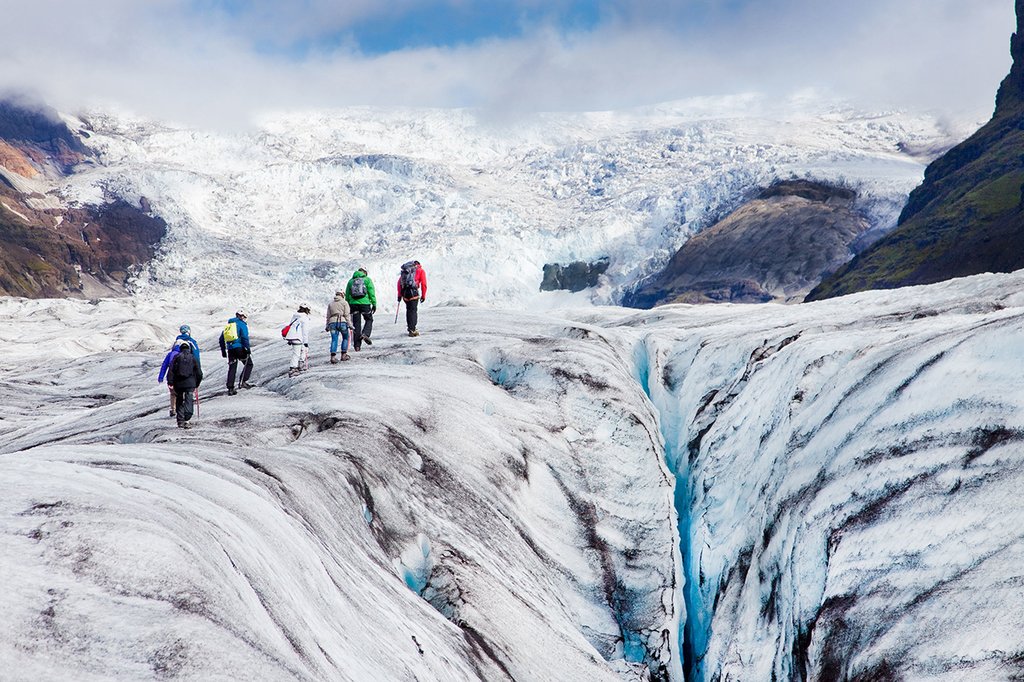Getting Oriented

Iceland is home to nearly 270 named glaciers, which cover over 10% of its landmass. These glaciers come in all shapes, sizes, and forms, including ice caps, outlet glaciers, alpine, mountain, cirque, and more. Iceland is even home to Europe's largest glacier, Vatnajökull, which connects to many other outlet glaciers on the South Coast. Learn what all these types of glaciers are, how they helped form the country throughout the millennia, and how they're connected to Iceland's volcanic activity.
Although beautiful to simply look at, you can explore Iceland's glaciers in unique ways, with snowmobiles and hikes, through ice caves and iceberg lagoons, and via kayaks and boat tours. The most popular and accessible glaciers are along the southern stretch of the famous Ring Road, but you can find these ice caps in all regions of Iceland. Other popular glaciers are in the Golden Circle and Northern Iceland.
On Top of Glaciers
To get up close with Iceland's glaciers, you can explore the top of these ice caps with snowmobiling, hiking, and walking through ice caves.
Skaftafell Ice Cave Tour & Glacier Walk

Skaftafell Nature Reserve sits within Vatnajökull National Park, home to Europe's largest glacier. Here, you can combine two of Iceland's most popular activities: exploring blue-hued ice caves and walking across a glacier. As you follow your guide along the ice, learn more about how glaciers form and why they're connected to the regional mountains and volcanoes. Then, head into the caves and enjoy the unique ice formations that emerge each winter. Read More
Vatnajökull Glacier Hike

Vatnajökull is Europe's largest glacier, and you can walk atop it! You'll hike up the glacier's "tongue" to reach the top of the ice cap and enjoy the best views. In addition, you'll have the opportunity to see some of the cracks and blue crevices and learn about the geology behind the phenomenon. On a clear day, you might be able to see glimpses of Hvannadalshnúkur, Iceland's highest peak, in the distance. Read More
Langjökull Glacier Snowmobiling

To explore Iceland's ice caps a bit more thoroughly, you can use a snowmobile to glide across the snow and ice of Langjökull Glacier, which offers amazing views of its unique surroundings. You'll get up close with the vast countryside and endless mountain ranges, a rare sight for many travelers. Read More
Chat with a local specialist who can help organize your trip.
Boat Tours
Glaciers are ice, and ice eventually melts into water, so to truly get to know Iceland's ice caps, you need to explore their glacial lagoons.
Sólheimajökulll Glacier Lagoon Kayaking

Although hiking across the glacier is a bit more common, you can discover Sólheimajökull from a different perspective with a kayaking tour. Paddle into the glacier's idyllic lagoon and bask in the beautiful nature around you. As you glide around this famous outlet glacier, observe the unique landscape and pass massive icebergs anchored in the lagoon. Eventually, some will break up and float out to sea. Read More
Fjallsarlon Glacier Lagoon Boat Tour

Although the neighboring Jökulsárlón Glacier Lagoon is a bit more popular, Fjallsárlón Glacier Lagoon is an excellent alternative to Iceland's most popular sites. You'll enjoy a boat tour that takes you close to some of the area's largest icebergs. On occasion, these icebergs turn over to reveal clean, ancient ice that you can taste! You'll also view the massive Vatnajökull Glacier by boat and learn more about Iceland's important ice caps. Read More
Glaciers & Canyons
When glaciers melt and recede, they form canyons and valleys. And because the country has historically been covered in ice, you'll find some of Europe's most beautiful and intricate canyons in Iceland.
Explore Canyons & Glaciers of Vík

Enjoy a mini road trip cruising along this stretch of the Ring Road between Vík and Höfn, stopping to explore its canyons and glaciers. Some highlights of the region include the rock formations of Fjaðrárgljúfur Canyon, the wilderness and waterfalls of Skaftafell, and the Fjallsárlón and Jökulsárlón Glacier Lagoons, which offer unique views of floating icebergs as they make their way out to sea. Read More
How to Craft the Perfect Glacier Itinerary in Iceland

Getting to Iceland's most popular and accessible glaciers is simple thanks to the country's Ring Road. The southern portion of this route passes by two of the country's largest and most picturesque glaciers, making it easy to add glacier experiences to any itinerary. You can enjoy day trips from Reykjavík or use the coastal city of Vík as a hub. Or, enjoy a road trip along the Ring Road and stop to enjoy the glaciers along the way.
To truly experience what Iceland has to offer, try to give yourself at least one week in the country. With 6 or 7 days, you can see Reykjavík and add in the Golden Circle and/or South Coast. With two weeks in Iceland, you can drive the entire Ring Road and stop in the East Fjords and Northern Iceland.
Remember that if you're traveling to Iceland in the winter, you'll have limited daylight. So, it helps to tack on an extra day or two in the dark seasons.
Past kimkim travelers have enjoyed the following itineraries that involve glacier experiences:
